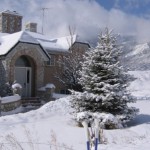 It’s winter, and although most of the time it’s pretty mild here in the South, we do get our bouts of cold and wintry weather. It’s the more extreme temperature changes that can wreak havoc on a roof and southern cold is no different. For well maintained roofs, temperature changes shouldn’t be much of an issue but for the less-maintained, winter can be problematic. Keeping your roof in shape is key to your roof surviving harsh weather, and if you’re not sure of the current state of your roof, the following tips can help your roof fare better in cold weather, but isn’t an alternative to professional roof inspection, when in doubt call a pro.
It’s winter, and although most of the time it’s pretty mild here in the South, we do get our bouts of cold and wintry weather. It’s the more extreme temperature changes that can wreak havoc on a roof and southern cold is no different. For well maintained roofs, temperature changes shouldn’t be much of an issue but for the less-maintained, winter can be problematic. Keeping your roof in shape is key to your roof surviving harsh weather, and if you’re not sure of the current state of your roof, the following tips can help your roof fare better in cold weather, but isn’t an alternative to professional roof inspection, when in doubt call a pro.
Make Your Shingles Stick
So you’re checking your roof and you see a few loose shingles, nothing major, but the adhesive doesn’t seem to be working properly. If your roof is under warranty, you can call your roof contractor and see if this is covered. If it’s outside the warranty or not covered consider this: Typically in the summer months, keeping the adhesive at least 60 degrees to maintain “stickiness” is easy, in the winter, not so much. If the adhesive is failing during cold weather, this must be fixed immediately. One easy way to make them stick properly is to use roofing cement, which must be applied to each individual shingle in the right amount to be effective, of course you can nail them down as well, but usually, this is best left to those who know what they are doing as nails can do damage if not used properly.
Doing this to a couple of shingles is acceptable until you can have your roof inspected for other damage, but if you find a lot of loose shingles, contact a professional as soon as possible as this could indicate a larger problem.
Ice Dams
Preventative maintenance is key during the colder months as the most common problem affecting roofs during this time is Ice Dams. These are difficult to get rid of as you can damage the roof chiseling or picking it and melting it with rock salt or calcium chloride can take forever. Using heat tape or a heat cable to deal with ice dams, as they run a constant stream of heat along areas most prone to damming, can be a solution but be wary, some of these products have been linked to house fires, so speak to your roofing professional or do your research to ensure you aren’t taking unnecessary risks. Keeping gutters clean and the roof clear of debris will help prevent ice damming however if ice dam’s still form after cleaning you will want to contact a roof contractor to have a full inspection performed.
Don’t Cover Your Turbines!
Many people like to cover and plug every open area of their home to keep the cold out. One mistake many people make is to seal the turbine on their roof in a vain attempt to keep the cold out. The turbines purpose is to vent moisture and condensation out of the house. By covering this, moisture and condensation are trapped inside the home and build up, causing problems. Homes have insulation installed in attics to keep your home warm in the winter, the turbine doesn’t affect temperature and covering it only harms your home.
As roof repairs are temperature sensitive (many components cannot be installed in sub-freezing temperatures), take care of the problem before it gets too cold and causes you headaches, call Atlanta Roofing Specialists today and keep your roof healthy all year round!
